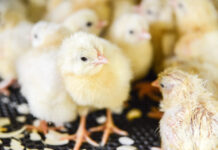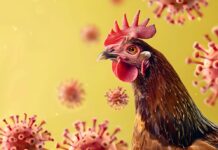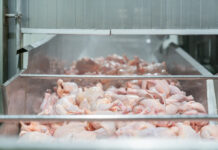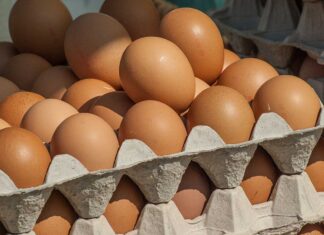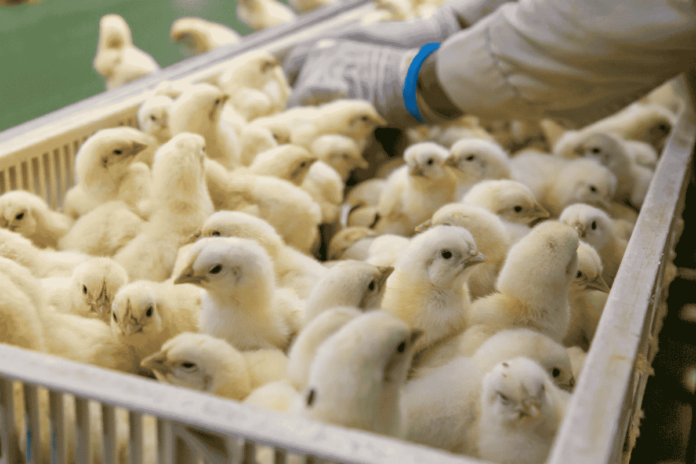
The PHOTOCATALYTIC GATE is a unique and effective system for air and surface disinfection in livestock facilities. This technology has been thoroughly tested in laboratory settings and real-life conditions at poultry hatcheries.
A major problem in poultry production is the presence of pathogenic bacteria and viruses in the air. Unfortunately, hatcheries and poultry farms are particularly vulnerable to contamination by bacteria, viruses, and fungi, which can cause serious infectious diseases:
- Salmonella – a bacterium that causes salmonellosis, a serious digestive tract infection,
- Escherichia coli – a bacterium that causes colibacillosis, leading to intestinal infections and sepsis.
- Influenza A virus – responsible for avian influenza (HPAI), an acute systemic disease with a mortality rate of up to 100%,
- Orthoavulovirus javaense (OAV-J) – the causative agent of Newcastle disease (ND), a highly contagious illness,
- Aspergillus – a mould that can cause aspergillosis, a lung disease in chicks.
Pathogens threaten poultry production throughout the cycle, from breeding flocks and hatcheries to broiler farms and slaughterhouses. Poultry infections result in significant financial losses for farmers and pose a consumer risk.
Salmonella bacteria naturally live in the intestines of healthy birds. They multiply quickly in the digestive tract, even in so-called asymptomatic carriers. The risk of infection increases when factors that weaken the animals’ immunity arise, such as excessively high bird density in the henhouse, insufficient air ventilation, or damp litter. The spread of viruses and bacteria can also occur through contaminated feed, water, fertiliser, excrements, equipment, and transport, as well as through humans – contaminated clothing, footwear, or tools can lead to mass infections of poultry and eggs.
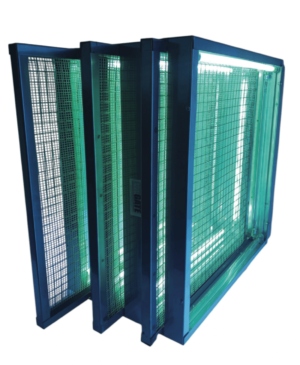
The use of antibiotics in poultry farming is permitted only for treatment and under the strict supervision of a veterinarian. After completing antibiotic therapy, a withdrawal period applies – the time required for the drug’s components to break down to a level safe for human health. Another significant issue, particularly on farms, is the emission of unpleasant odours into the environment. Complaints and protests from nearby residents often delay the planning, construction, and operation of farms. The issue of odour nuisance undeniably damages the reputation of the entire agricultural industry, including poultry farming. Therefore, innovative solutions are needed to address the challenges of profitable and sustainable poultry production. These solutions should reduce pharmacological treatments, minimise odour emissions, and water and air pollution, and align with sustainable development principles. Additionally, they should ensure food safety, protect workers, and safeguard the environment.
The PHOTOCATALYTIC GATE is a unique and effective system for air and surface disinfection in livestock facilities (Figure 1). This technology has been thoroughly tested in laboratory settings and real-life conditions at poultry hatcheries. The PHOTOCATALYTIC GATE operates based on photocatalysis, in which two key elements – the appropriate photocatalyst and the proper light source – enable the decomposition of organic and microbiological contaminants (Figure 2).
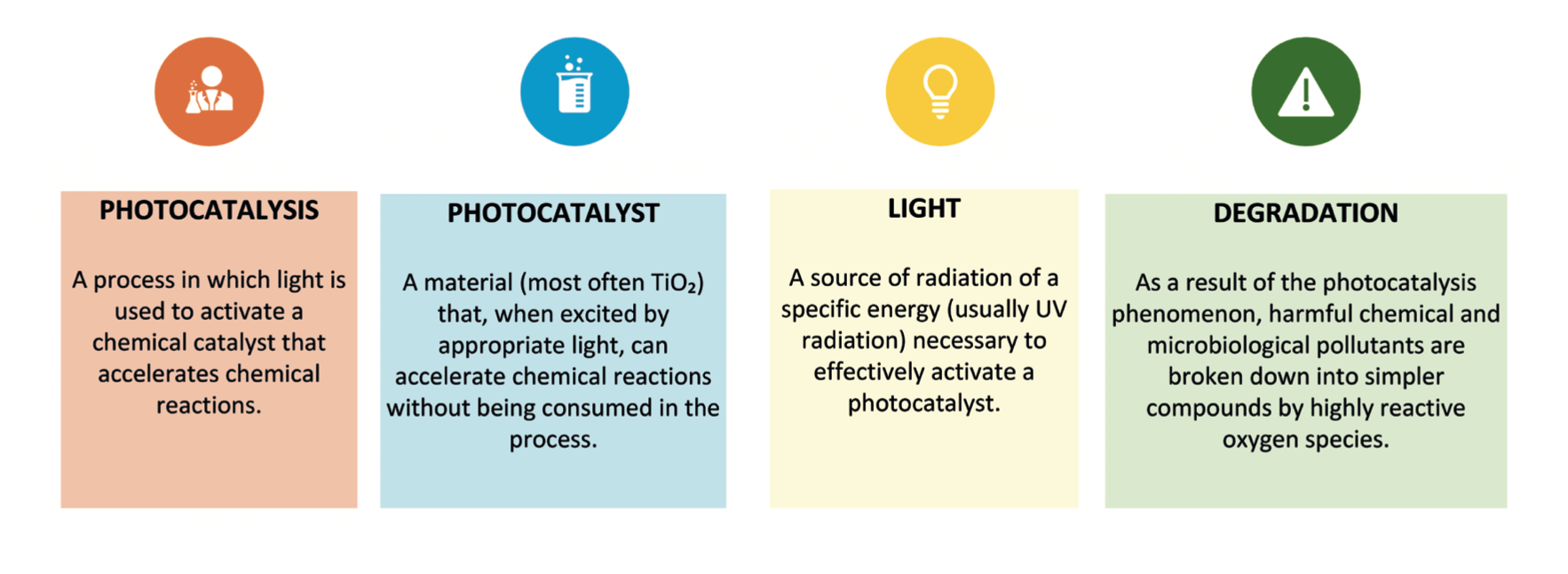
The active element of the technology is a photocatalyst – titanium dioxide (TiO2) absorbs UV light when exposed to it and in the presence of oxygen and moisture leads to the formation of reactive oxygen compounds (ROS), such as the hydroperoxide radical (HO2•), the hydroxyl radical (HO•) and hydrogen peroxide (H2O2) (Figure 3).
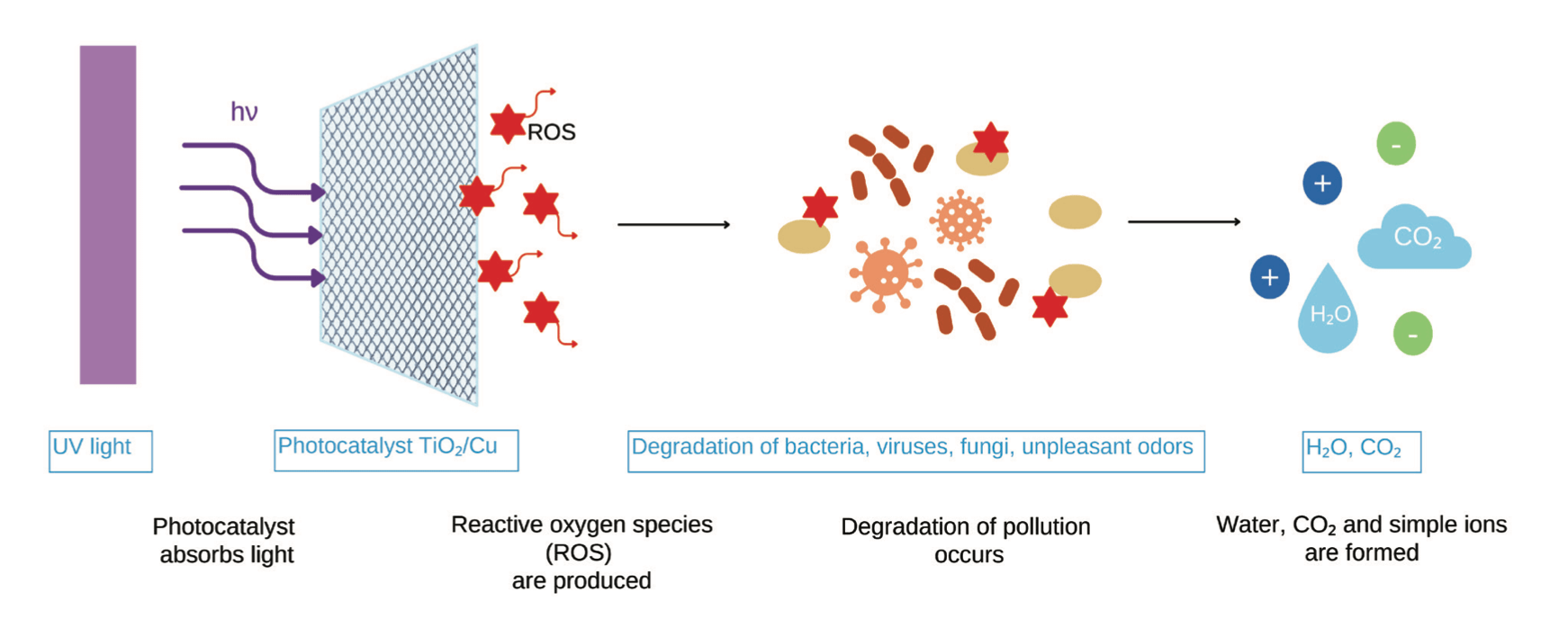
The key to the PHOTOCATALYTIC GATE’s effectiveness is selecting the appropriate UV light source, which initiates the oxidation reaction and generates small amounts of ozone. Due to the strong oxidising properties of ROS molecules, all organic and microbiological pollutants are decomposed (oxidised) into simple substances like carbon dioxide and water. When polluted air comes into contact with the photoactive TiO₂ coating, it is purified of allergens, bacteria, moulds, yeasts, viruses, and toxic pollutants. The photocatalytic coating has been enhanced with copper compounds to improve its effectiveness in purifying air from various pollutants in livestock facilities. This includes reducing unpleasant odours caused by the decomposition of litter and manure, as well as inhibiting the growth of mould and fungi, particularly in damp and poorly ventilated areas. The addition of copper compounds further boosts the TiO₂ photocatalyst’s ability to deactivate mould and fungi. The efficiency of the PHOTOCATALYTIC GATE is not accidental. Many years of laboratory research on understanding the mechanism of photocatalysis and the impact of various factors on its efficiency were conducted by a team of experienced scientists under the supervision of Professor Wojciech Macyk from the Faculty of Chemistry at Jagiellonian University.
The author of PHOTOCATALYTIC GATE technology, which combines photocatalysis with a small dose of ozone and introduces many innovative solutions, is Eng. Piotr Czech (dezynfekcjapowietrzem.pl), a specialist in ventilation and air conditioning technologies. His prototype installation at a poultry hatchery led to the elimination of pathogens, including Salmonella spp.
The PHOTOCATALYTIC GATE technology was optimised and tested at InPhoCat by Dr. Joanna Macyk and Prof. Wojciech Macyk for nearly four years. It has been confirmed that the appropriate combination of photocatalyst (TiO2), UV light with a minimal dose of ozone (UV/O3), and copper compounds (Cu2+) delivered excellent results in durability tests, decomposition of organic compounds, and, most importantly, the decomposition of microbiological contaminants.
This is evidenced by microbiological tests conducted on air and surfaces in many independent laboratories, including:
- Microbiological tests for Salmonella enterica, Enterococcus faecalis, and Staphylococcus aureus tested in the accredited Laboratory of the Institute of Agricultural and Food Biotechnology – State Research Institute in Łódź.
- Microbiological tests for enveloped viruses such as coronaviruses (including SARS-CoV-2), measles virus, varicella virus, influenza virus, herpes simplex virus, HIV, hepatitis C, hepatitis B, hepatitis D, EBOLA, and Marburg (tests on the model strain Vaccinia Virus) conducted by the MEDISEPT Sp. z o.o., Research and Development Center.
- Tests against gram-positive (+) and gram-negative (-) bacteria for antibiotic-resistant bacterial strains: Klebsiella pneumoniae NDM-1, Acinetobacter baumannii, Pseudomonas aeruginosa, Staphylococcus aureus MRSA, Clostridium difficile, Escherichia coli and Enterococcus hirae – conducted by the MEDISEPT Sp. z o.o., Research and Development Center.
Studies conducted under real conditions at a poultry hatchery confirmed that the issue of Salmonella presence persisted despite the use of standard biosecurity procedures. In 28% of the tested samples, Salmonella was detected before the installation of the PHOTOCATALYTIC GATE technology (red bars in Figure 4). Since the implementation of the PHOTOCATALYTIC GATE technology alongside biosecurity measures, Salmonella has been reduced (blue bars in Figure 4) and finally eliminated (value 0% in Figure 4). The results of these studies confirm the high efficacy of the photocatalytic system.

The microbiological effectiveness under real conditions has been confirmed through scientific research conducted by a team of zoohygienists and microbiologists, supervised by Prof. Eng. Marcin Lis, from the Agriculture University of Kraków at the Poultry Hatching Department. Following the installation of PHOTOCATALYTIC GATES, a reduction in the population of aerobic mesophilic microorganisms was observed at the following measurement points: the incubator ventilation unit (a decrease of 0.7 log cfu/25 cm²) and the hatcher ventilation unit (a decrease of 0.3 log cfu/25 cm²). The PHOTOCATALYTIC GATES effectively reduced the number of Enteric Bacilli, Staphylococcus, and fungi in the incubator ventilation unit. They also limited the number of fungi in the hatcher ventilation unit (see Table 1).
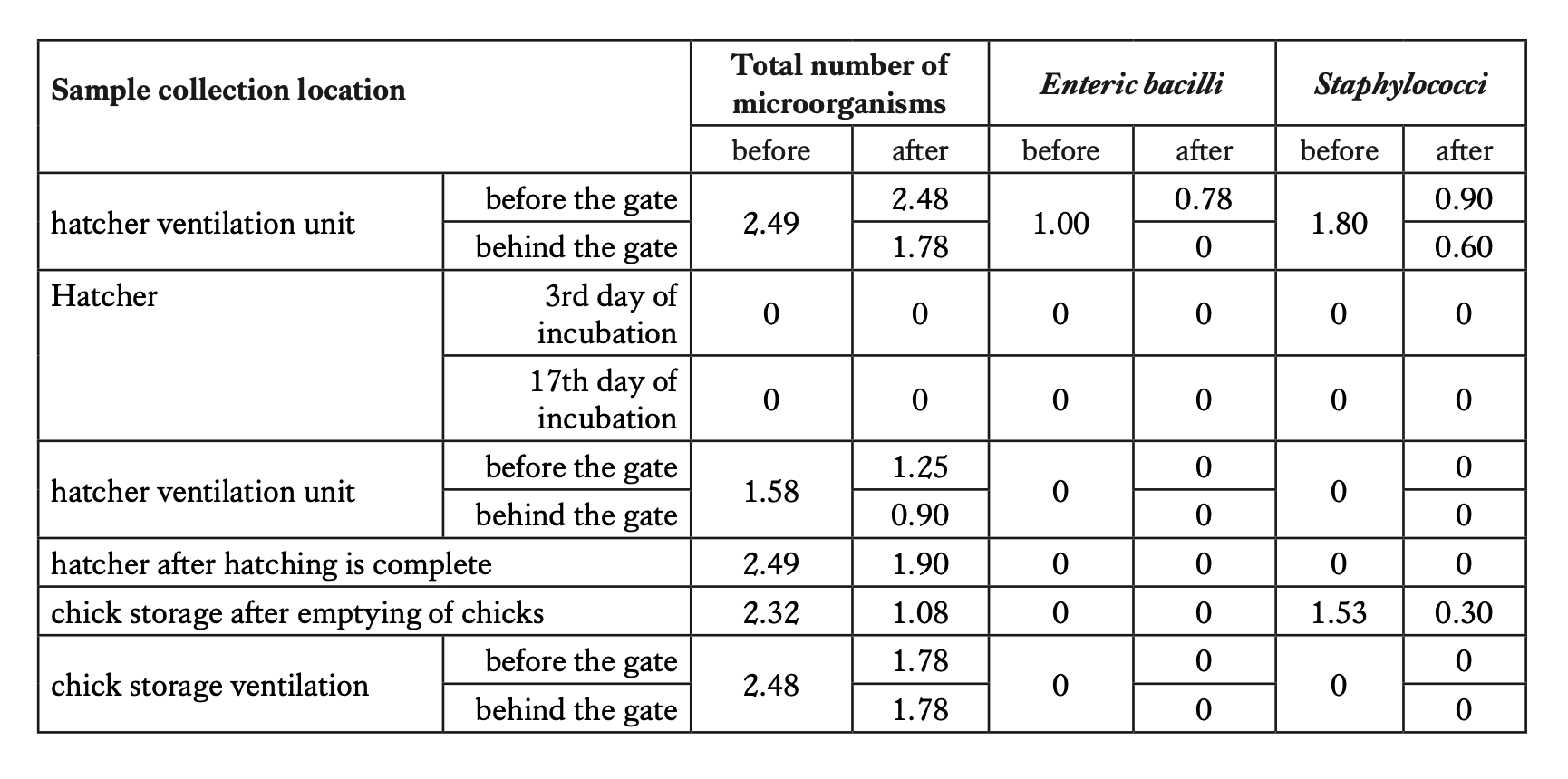
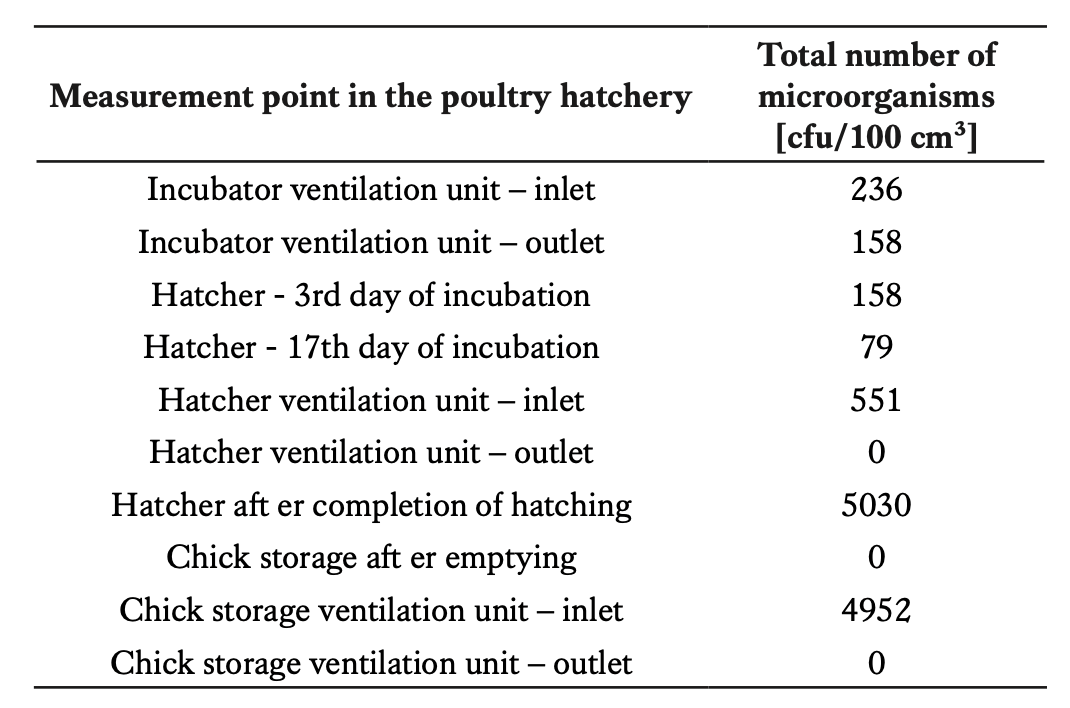
During the tests, it was not found that the use of the PHOTOCATALYTIC GATE affected air parameters such as temperature, relative humidity, and movement. The photocatalytic decomposition of pollutants into carbon dioxide does not affect the increase of CO2 in the air and therefore does not deteriorate our air quality. Since the concentration of harmful gaseous admixtures (NH3 and H2S) in the Poultry Hatching Plant (PHP) rooms remained below the detection limit level of the devices, it cannot be determined whether the device could have affected these parameters.
The PHOTOCATALYTIC GATE, although not effective against dust with diameters between 2.0-10 µm, significantly reduced the concentration of the most harmful, smallest respirable dust particles in the range 8-31%. Interestingly, the effect of this dust fraction seemed to persist in rooms where air purified by the PHOTOCATALYTIC GATE was injected. The concentration of nanodusts in these hatching devices and sorting rooms was approximately 86-92% of the value measured in the air directly behind the working PHOTOCATALYTIC GATE, and even 19% in the chick warehouse. This effect on the larger diameter dust fraction was not observed.
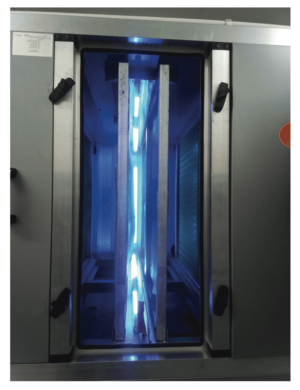
In hatcheries equipped with ventilation units, PHOTOCATALYTIC GATES are mounted on the supply air inside the devices or on the supply duct (Figure 5). It is also recommended to install the system at the air outlets. This would significantly reduce the unpleasant odour nuisance of livestock buildings in the local environment. For the disinfection of semi-trailers (with isothermal or refrigerated/heated trucks used for transporting), it is possible to install a PHOTOCATALYTIC GATE in the space where the fans of the ventilation, heating, and cooling systems of the semi-trailer are located.
The PHOTOCATALYTIC GATE technology can be effectively implemented in poultry farms for all types of mechanical ventilation systems: cross, chimney, or tunnel, whether overpressure or underpressure, as long as all ventilation air inlets are protected. It is also possible to use monoblock devices with their own fans, operating on recirculating air, which significantly reduces investment and operating costs. However, this solution will be less efficient
The benefits of installing a PHOTOCATALYTIC GATE in the mechanical supply and exhaust ventilation system in a poultry hatchery are as follows:
- disinfects the flowing air at a level of 90 to 99% thanks to the appropriate power of UV light
- disinfects ventilation ducts and air and surfaces in rooms with an efficiency of over 99% thanks to the use of a TiO2/Cu photocatalytic coating,
- 100% effectiveness against Salmonella enterica (Salmonellosis),
- significant reduction in chick mortality rates,
- elimination of costly antibiotic treatments,
- protection against antibiotic withdrawal,
- maintenance of a safe, bacteria-free, virus-free, fungi-free, and mould-free ventilation system,
- improvement in air quality circulation, leading to better livestock welfare,
- reduction in respirable dust with a diameter of <0.3 μm by 9.3 to 20.6% and <0.5 μm by 8 – 31%,
- enhanced biosecurity against cross-infections,
- strengthened biosecurity in preventing infections transmitted by personnel,
- improved working conditions,
- reduction of bacterial and spore spread on the premises,
- decreased emission of harmful pollutants to the external environment.
- guarantees efficiency and protection for about 2 years, after which a service inspection should be carried out and the catalytic matrix should be replaced.
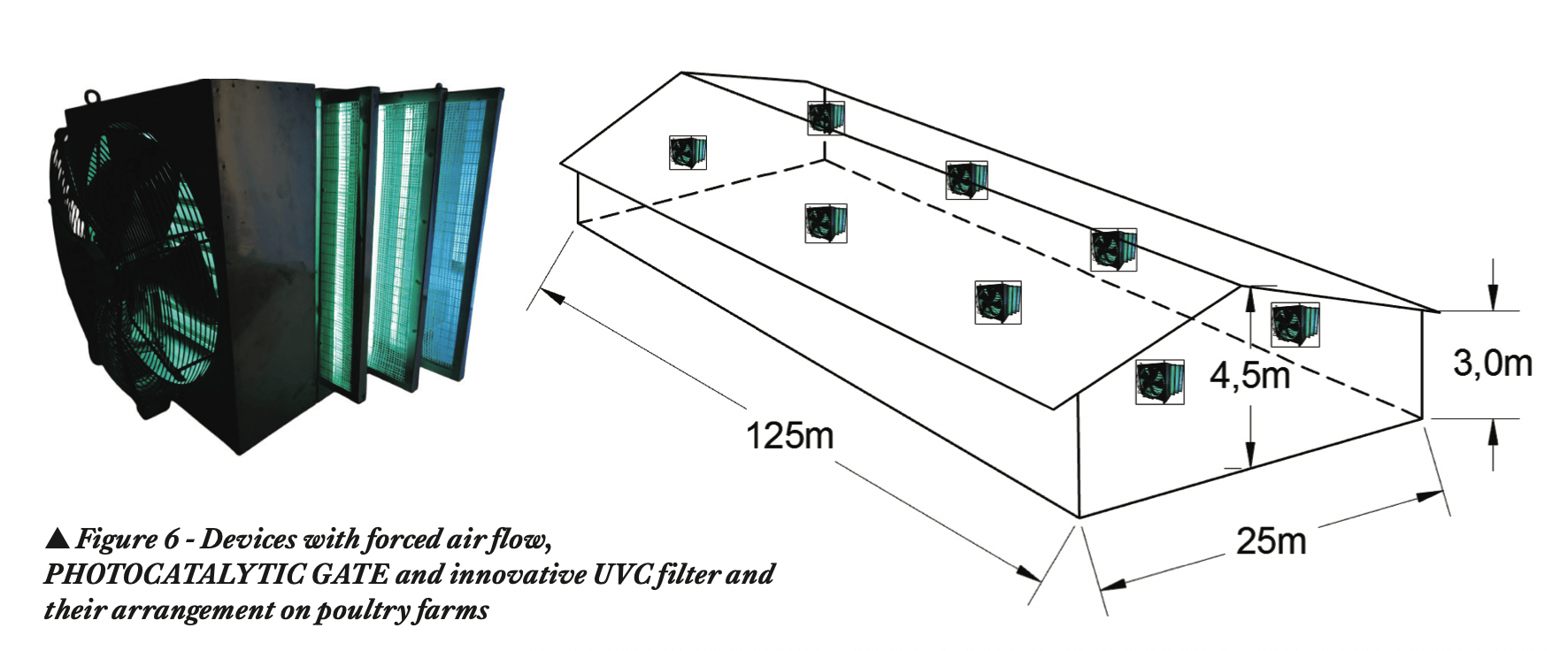 The patented solutions used in the PHOTOCATALYTIC GATE consist of:
The patented solutions used in the PHOTOCATALYTIC GATE consist of:
- securing the entire cross-section of the airflow in the supply duct or the cross-section of the ventilation unit,
- universal design – the possibility of using several rows of photocatalytic matrices, which provides the most effective protection while maintaining the recommended ventilation efficiency of the facility,
- easy servicing – the entire device is pulled out on special rails outside the ventilation unit section, which facilitates the replacement of UV lamps, ballasts and photocatalytic filters.
In the era of global threats of diseases such as Salmonellosis, Avian Influenza (HPAI) and Newcastle Disease (ND), the PHOTOCATALYTIC GATE Technology is an excellent complement to biosecurity in breeding facilities. It is also the right solution for safe poultry production, allowing for a reduction in the amount of pharmaceuticals used and non-invasive protection of animals and personnel as well as the environment surrounding the farms.
The PHOTOCATALYTIC GATE® has obtained the safety conformity certificate, including a test of nano-object emissions conducted by the Central Institute for Labor Protection – National Research Institute (CIOP), which confirms that particles of the TiO2/Cu coating do not penetrate the room with the ventilation air.
In addition, the Ozone-free solution has a Certificate of National Institute of Public Health no.: B.BK.60112.0130.2023 valid until: 06.07.2028 for use in livestock facilities.
The entire technology is protected by a patent application in the Patent Office of the Republic of Poland no. P.4441199 and an international patent application – World Intellectual Property Organization WIPO PCT no. PCT/IB2023/053731 and European Patent Office no. 23807114.6-1014 PTC/IB2023053731, as well as numerous EU industrial designs.
PHOTOCATALYTIC GATE® received the “QUALITY & INNOVATION” award in the Innovation category at the POULTRY TECH and BIOAGRO POLSKA 2024 Fairs.


